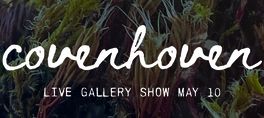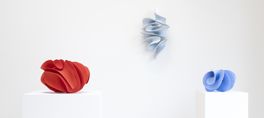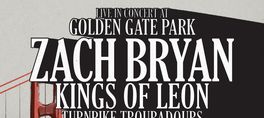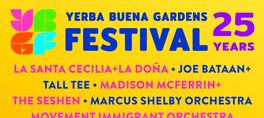This body of work marks an important turning point for the San Francisco-based artist, who has been a figurative painter his entire life. Desiring the challenges and stimulation of a new aesthetic, Brown recently turned to abstraction as a way of breaking down illusory space into its essential elements. This dismantling and exploration of compound forms has been a slow, cautious project for Brown. Winterscape #1 and #2, for instance, feature imagery reminiscent of bare branches on a raw winter day. The primitive naturalism of these two intermediary paintings, however, ultimately gives way to bold, abstract gestures, while a black and white color palette is expanded to include bright, largely primary colors.
Brown creates a new gestural line in this body of work by applying paint with a brayer rather than a brush. The resulting markings—which are placed sparingly and deliberately—are relatively consistent in width, weight, and value. A type of hand roller, the brayer lends itself well to the creation of perfectly curvilinear forms, which Brown arranges to push energy out, funnel energy in, or pull energy down. This activity is augmented by shadowy echoes produced by a brayer spent of its paint, the canvases’ grand scale, and the paintings’ smooth, encaustic-like surfaces. The final compositions induce a kind of synesthetic effect, awakening waves of sound that parallel their elegant visual reverberations. It is no wonder Brown identifies Igor Stravinsky, composer of the animalistic and boldly avant-garde The Rite of Spring, as one of his artistic inspirations.
While Brown’s paintings—especially those in grayscale, such as June 28th #1 and Composition #1—are reminiscent of works by Richard Serra, Franz Kline, and Robert Motherwell, Brown cites Marcel Proust’s The Remembrance of Thing Past as the oeuvre’s greatest inspiration. At seven volumes long, this groundbreaking literary achievement focuses not on action and plot, but on interiority and the relationship between experience and memory. Brown says, “I discovered what a monumental artistic achievement Proust had accomplished. He changed my world. All these paintings were painted while I listened to those unabridged audiobooks. I'm currently in my fifth reading, and I'm getting to know it well. Proust’s work has been a constant reminder to be honest with myself and my work.”
In addition to Proust, Brown also identifies Caravaggio (see Composition #2 After Caravaggio), Henri Matisse (see Three Circles), and Francis Bacon as core influences. While his paintings indisputably build upon and answer to both abstract expressionism and minimalism, their sensuousness challenges the stark masculinity we come to expect for abstract expression while an affinity for experimentation subverts the control and premeditation that underlies minimalism. “It’s the accidents,” Brown says, “that keep feeding me more ideas.”
Charley Brown was born in 1945 in Barstow, California. He studied at California College of the Arts in Oakland, CA, and received both his BA and MA in Art from Humbolt State University. In addition to exhibiting in galleries across the United States and Europe, Brown has shown at the New Museum, New York City and has had murals commissioned by the Smithsonian Institute, the New Main Library of San Francisco, and Stanford University. This will be his first solo exhibition at the Dolby Chadwick Gallery.
show less
Brown creates a new gestural line in this body of work by applying paint with a brayer rather than a brush. The resulting markings—which are placed sparingly and deliberately—are relatively consistent in width, weight, and value. A type of hand roller, the brayer lends itself well to the creation of perfectly curvilinear forms, which Brown arranges to push energy out, funnel energy in, or pull energy down. This activity is augmented by shadowy echoes produced by a brayer spent of its paint, the canvases’ grand scale, and the paintings’ smooth, encaustic-like surfaces. The final compositions induce a kind of synesthetic effect, awakening waves of sound that parallel their elegant visual reverberations. It is no wonder Brown identifies Igor Stravinsky, composer of the animalistic and boldly avant-garde The Rite of Spring, as one of his artistic inspirations.
While Brown’s paintings—especially those in grayscale, such as June 28th #1 and Composition #1—are reminiscent of works by Richard Serra, Franz Kline, and Robert Motherwell, Brown cites Marcel Proust’s The Remembrance of Thing Past as the oeuvre’s greatest inspiration. At seven volumes long, this groundbreaking literary achievement focuses not on action and plot, but on interiority and the relationship between experience and memory. Brown says, “I discovered what a monumental artistic achievement Proust had accomplished. He changed my world. All these paintings were painted while I listened to those unabridged audiobooks. I'm currently in my fifth reading, and I'm getting to know it well. Proust’s work has been a constant reminder to be honest with myself and my work.”
In addition to Proust, Brown also identifies Caravaggio (see Composition #2 After Caravaggio), Henri Matisse (see Three Circles), and Francis Bacon as core influences. While his paintings indisputably build upon and answer to both abstract expressionism and minimalism, their sensuousness challenges the stark masculinity we come to expect for abstract expression while an affinity for experimentation subverts the control and premeditation that underlies minimalism. “It’s the accidents,” Brown says, “that keep feeding me more ideas.”
Charley Brown was born in 1945 in Barstow, California. He studied at California College of the Arts in Oakland, CA, and received both his BA and MA in Art from Humbolt State University. In addition to exhibiting in galleries across the United States and Europe, Brown has shown at the New Museum, New York City and has had murals commissioned by the Smithsonian Institute, the New Main Library of San Francisco, and Stanford University. This will be his first solo exhibition at the Dolby Chadwick Gallery.
This body of work marks an important turning point for the San Francisco-based artist, who has been a figurative painter his entire life. Desiring the challenges and stimulation of a new aesthetic, Brown recently turned to abstraction as a way of breaking down illusory space into its essential elements. This dismantling and exploration of compound forms has been a slow, cautious project for Brown. Winterscape #1 and #2, for instance, feature imagery reminiscent of bare branches on a raw winter day. The primitive naturalism of these two intermediary paintings, however, ultimately gives way to bold, abstract gestures, while a black and white color palette is expanded to include bright, largely primary colors.
Brown creates a new gestural line in this body of work by applying paint with a brayer rather than a brush. The resulting markings—which are placed sparingly and deliberately—are relatively consistent in width, weight, and value. A type of hand roller, the brayer lends itself well to the creation of perfectly curvilinear forms, which Brown arranges to push energy out, funnel energy in, or pull energy down. This activity is augmented by shadowy echoes produced by a brayer spent of its paint, the canvases’ grand scale, and the paintings’ smooth, encaustic-like surfaces. The final compositions induce a kind of synesthetic effect, awakening waves of sound that parallel their elegant visual reverberations. It is no wonder Brown identifies Igor Stravinsky, composer of the animalistic and boldly avant-garde The Rite of Spring, as one of his artistic inspirations.
While Brown’s paintings—especially those in grayscale, such as June 28th #1 and Composition #1—are reminiscent of works by Richard Serra, Franz Kline, and Robert Motherwell, Brown cites Marcel Proust’s The Remembrance of Thing Past as the oeuvre’s greatest inspiration. At seven volumes long, this groundbreaking literary achievement focuses not on action and plot, but on interiority and the relationship between experience and memory. Brown says, “I discovered what a monumental artistic achievement Proust had accomplished. He changed my world. All these paintings were painted while I listened to those unabridged audiobooks. I'm currently in my fifth reading, and I'm getting to know it well. Proust’s work has been a constant reminder to be honest with myself and my work.”
In addition to Proust, Brown also identifies Caravaggio (see Composition #2 After Caravaggio), Henri Matisse (see Three Circles), and Francis Bacon as core influences. While his paintings indisputably build upon and answer to both abstract expressionism and minimalism, their sensuousness challenges the stark masculinity we come to expect for abstract expression while an affinity for experimentation subverts the control and premeditation that underlies minimalism. “It’s the accidents,” Brown says, “that keep feeding me more ideas.”
Charley Brown was born in 1945 in Barstow, California. He studied at California College of the Arts in Oakland, CA, and received both his BA and MA in Art from Humbolt State University. In addition to exhibiting in galleries across the United States and Europe, Brown has shown at the New Museum, New York City and has had murals commissioned by the Smithsonian Institute, the New Main Library of San Francisco, and Stanford University. This will be his first solo exhibition at the Dolby Chadwick Gallery.
read more
Brown creates a new gestural line in this body of work by applying paint with a brayer rather than a brush. The resulting markings—which are placed sparingly and deliberately—are relatively consistent in width, weight, and value. A type of hand roller, the brayer lends itself well to the creation of perfectly curvilinear forms, which Brown arranges to push energy out, funnel energy in, or pull energy down. This activity is augmented by shadowy echoes produced by a brayer spent of its paint, the canvases’ grand scale, and the paintings’ smooth, encaustic-like surfaces. The final compositions induce a kind of synesthetic effect, awakening waves of sound that parallel their elegant visual reverberations. It is no wonder Brown identifies Igor Stravinsky, composer of the animalistic and boldly avant-garde The Rite of Spring, as one of his artistic inspirations.
While Brown’s paintings—especially those in grayscale, such as June 28th #1 and Composition #1—are reminiscent of works by Richard Serra, Franz Kline, and Robert Motherwell, Brown cites Marcel Proust’s The Remembrance of Thing Past as the oeuvre’s greatest inspiration. At seven volumes long, this groundbreaking literary achievement focuses not on action and plot, but on interiority and the relationship between experience and memory. Brown says, “I discovered what a monumental artistic achievement Proust had accomplished. He changed my world. All these paintings were painted while I listened to those unabridged audiobooks. I'm currently in my fifth reading, and I'm getting to know it well. Proust’s work has been a constant reminder to be honest with myself and my work.”
In addition to Proust, Brown also identifies Caravaggio (see Composition #2 After Caravaggio), Henri Matisse (see Three Circles), and Francis Bacon as core influences. While his paintings indisputably build upon and answer to both abstract expressionism and minimalism, their sensuousness challenges the stark masculinity we come to expect for abstract expression while an affinity for experimentation subverts the control and premeditation that underlies minimalism. “It’s the accidents,” Brown says, “that keep feeding me more ideas.”
Charley Brown was born in 1945 in Barstow, California. He studied at California College of the Arts in Oakland, CA, and received both his BA and MA in Art from Humbolt State University. In addition to exhibiting in galleries across the United States and Europe, Brown has shown at the New Museum, New York City and has had murals commissioned by the Smithsonian Institute, the New Main Library of San Francisco, and Stanford University. This will be his first solo exhibition at the Dolby Chadwick Gallery.
show less
Date/Times:
Dolby Chadwick Gallery
40 Upcoming Events
210 Post Street, San Francisco, CA 94108
The Best Events
Every Week in Your Inbox
From Our Sponsors
UPCOMING EVENTS
Great suggestion! We'll be in touch.
Event reviewed successfully.







